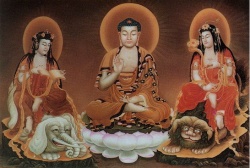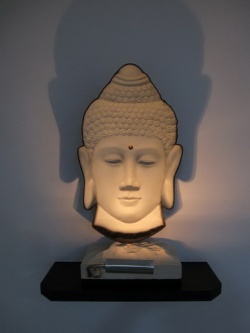Ghosts in Tibetan culture
There is widespread belief in ghosts in Tibetan culture. Ghosts are explicitly recognized in the Tibetan Buddhist religion as they were in Indian Buddhism, occupying a distinct but overlapping world to the human one, and feature in many traditional legends. When a human dies, after a period of uncertainty they may enter the ghost world. A hungry ghost (Tibetan: yidag, yi-dvags; Sanskrit: preta, प्रेत) has a tiny throat and huge stomach, and so can never be satisfied. Ghosts may be killed with a ritual dagger or caught in a spirit trap and burnt, thus releasing them to be reborn. Ghosts may also be exorcised, and an annual festival is held throughout Tibet for this purpose. Some say that Dorje Shugden, the ghost of a powerful 17th-century monk, is a deity, but the Dalai Lama asserts that he is an evil spirit, which has caused a split in the Tibetan exile community.
Tibetan Buddhists believe that when a person dies, they enter the intermediate Bardo state, from which they may be reborn in this world in a human or animal body, in the ghost world in a ghost body, in one of the paradise realms or in one of the hells. But eventually, the person will die in this after-death world and be reborn as a human or other creature unless they achieve Nirvana, where they are beyond all states of embodiment.
Hungry ghosts have their own realm depicted on the Bhavacakra and are represented as teardrop or paisley-shaped with bloated stomachs and necks too thin to pass food, so that attempting to eat is also incredibly painful. Some are described as having "mouths the size of a needle's eye and a stomach the size of a mountain". This is a metaphor for people futilely attempting to fulfill their illusory physical desires. Sometime individuals have a predominance of hungry ghost in their makeup. They can never get enough, and are always hungry for more. The Tibetan word for the emotional state of the hungry ghost, ser na, literally means "yellow nosed", and could be said to mean "meanness" or "lack of generosity". The person in this state is constantly seeking to consume and to enrich themselves, but can never be satisfied.
A tulpa is a type of ghost or being that is created through mental effort, purely from the thoughts of its creator. A very skilled Buddhist practitioner or sorcerer may have this ability, and in some cases a Tulpa may be created from the collective thoughts of the villagers. Such a ghost is not self-aware at first, but may gradually acquire awareness and go on to become a normal human being.
The phurba (Tibetan: ཕུར་བ, Sanskrit: kīla) is a ritual dagger used by a tantric practitioner to release an evil spirit from its suffering and guide it to a better rebirth. Such a spirit (ghost) is a being which lingers in confusion between different realms. By plunging the dagger into it, it is thrown out of its confusion and gets the chance to be reborn, probably as a lower kind than human.
Spirit traps
Families often mount ghost-traps on the roofs of their houses, spindle-like contraptions wound with colored yarns. A spirit trap may also be hung in a tree. The series of interlocking threads is thought to ensnare the spirit, and is burnt when the job is done.
Exorcising-Ghost day
The Tibetan religious ceremony 'Gutor' དགུ་གཏོར་, literally offering of the 29th, is held on the 29th of the 12th Tibetan month, with its focus on driving out all negativity, including evil spirits and misfortunes of the past year, and starting the new year in a peaceful and auspicious way.
The temples and monasteries throughout Tibet hold grand religious dance ceremonies, with the largest at Potala Palace in Lhasa. Families clean their houses on this day, decorate the rooms and eat a special noodle soup called 'Guthuk'. དགུ་ཐུག་ In the evening, the people carry torches, calling out the words of exorcism. A folk tale
A story tells of a man who met a ghost while out walking. The ghost started walking with him, which made him very frightened, although he hid his fear and pretended that he too was a ghost. They came to a town. The ghost left the man resting, entered the town and stole the soul of the king's son, tying it up in a yak hair sack. Returning to the man, the ghost left the sack in his care for a while. The man took the sack into the town, where the king was in great alarm because his son was dying. The man promised to revive the boy, conducting rituals and at the same time releasing the boy's soul from the bag. When the boy revived, the king gave the man half of all his property as reward.
Dorje Shugden is the ghost of a powerful 17th-century monk who was murdered in his palace in Tibet. His adherents consider that he is a deity. However, in the late 1970s the Dalai Lama reconsidered his faith in Dorje Shugden, and decided that the wrathful spirit was working against him, hampering his goal of seeking autonomy for Tibet with minimal interference from Beijing. This has caused a split between Tibetan exiles, with often bitter arguments between those who follow the Dalai Lama and those who continue to revere Dorje Shugden. The Western Shugden Society is one of these organizations.

